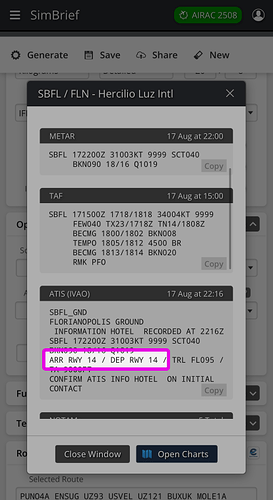Hello, I hope you’re all well!
I believe that every airport in the world has a preferred runway, that is, the runway that best suits operations when ATC has the option to choose one or the other due to weather conditions (VRB or calm winds, for example). This is no different in Brazil.
However, I notice that in certain circumstances, with calm or variable winds, Simbrief sometimes indicates the non-preferred runway, resulting in the following: those familiar with the area go to the correct runway. Those unfamiliar with the area (or newbies) go to the runway Simbrief indicated. This causes conflicts in the online networks when ATC (VATSIM) is not available, and it certainly increases traffic taxi times, potentially sending them onto more complicated approaches with fewer resources for no apparent reason.
For this reason, I’d like to help you by informing you of the preferred runway for Brazil’s main airports. This way, when the wind is variable (VRB) or calm (00000KT), this should be the runway in use indicated:
SBGR: 10L for takeoff, 10R for landings
SBSP: 17R for takeoffs and landings (PER/A and PER/B aircraft use 17L)
SBKP: 15 for takeoffs and landings
SBGL: 10 for takeoff, 15 for landings
SBRJ: 20L for takeoffs and landings (20R-02L is being used for taxi)
SBCF: 16 for takeoffs and landings
SBBR: 11R and 11L for takeoffs and landings
SBCT: 15 for takeoffs and landings
SBFL: 14 for takeoffs and landings
SBPA: 11 for takeoffs and landings
SBVT: 02 for takeoffs and landings
SBSV: 10 for takeoffs and landings
This means the following: in Brasília (SBBR), for example, with calm (00000KT) or variable (VRB) wind, Simbrief must indicate 11R/11L for takeoff/landing instead of 29L/29R.
There are a few other factors, for example: at Guarulhos (SBGR) and Galeão (SBGL), because they have long runways, operations only switch to the opposite runway in the event of a strong tailwind (considering dry runway), typically exceeding 7 knots (and this can be even higher at SBGL due to the nearby SBRJ airport, which causes conflicts). For example: it’s common to have a dry runway with wind 280 degrees with 5 knots at SBGR and have RWY 10L/R in use. I don’t know if there’s a way to configure this parameter. If so, I can provide them for you based on real life AIP.
Best regards!




